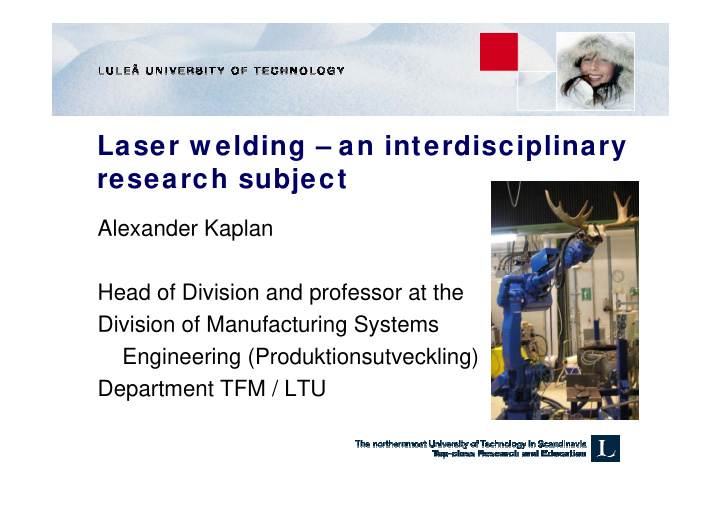



Laser w elding – an interdisciplinary research subject Alexander Kaplan Head of Division and professor at the Division of Manufacturing Systems Engineering (Produktionsutveckling) Department TFM / LTU
Division of Manufacturing Systems Engineering Teaching: Research: Production Engineering Laser processing Manufacturing Cutting µ-processing Surf. treatm. Automati- Laser Others sation processing Laser welding Production- planning, LEAN Area LUPO Production/Organisation Area Materials Science
Research disciplines addressed by laser processing Implementation: People, Psychology Factory layout, Logistics Laser systems, Sensors, Automation Laser process: Thermodynamics, Fluid flow Quantum physics, Optics Materials science Product properties: Material, Mechanics
LASER Laser Lab: 1 Yb:Fiberlaser: 15 kW cw 3 Nd:YAG laser: 3 kW cw, 250 W pw, 200 W Q-pw, FHG 2 CO 2 laser: 6 kW cw, 80 W pw (TEA, 4 J) 1 Excimer laser: 308 nm CyberLab (web-conference access): Disc laser : 4 kW – at Oulu U (FIN) 2 Nd:YAG laser: ESAB and Twente U div. Fiberlaser: D, FIN, UK, S, etc.
Our Ancillary Laser Equipment Gantry and industrial robots, xy-stages Galvanometer optics, fibre optics MAG welding set (hybrid welding) Powder delivery High speed imaging + illumination laser Thermocamera (avd. experim. mekanik) Seam tracking Beam analyser Reflectance measuring (Mid Sweden U) etc.
Laser Materials Processing Laser - - welding - surface treatment - micromachining - cutting - rapid prototyping
Current Welding Projects � DATLAS – observing weld quality defects � HYBRIGHT – hybrid weld properties � LOST – UHSS lightweight construction � NORHYB – Nordic hybrid welding network � FiberTube – Fiber laser welding, cutting � Filler wire impact on hybrid welding (ESAB) � High Tech decision making in Sweden � CyberLab – Lab experiments by videoconferencing (EU)
Laser w elding projects MS U-PhD LaserNova-PhD ESAB-PhD EU CyberLab FiberTube Production, Material System Product Mechanical development Process properties Process Joint type monitoring Ind.contracts 35 companies 12 academics HYBRIGHT DATLAS 6 LTU-divisions EU LaserTool LOST/KOST EU ISSEA NFR
Hybrid laser-arc w elding
Remote laser w elding
g n i r e d l o s r e s c a i n L o r t c e l e o r c i m f o s r e y a l i t l u m
Imaging of metal vapour
Imaging of the melt motion
Keyhole (melt cavity) collapse Mathematical model: Simulation of the keyhole collapse
Quality monitoring sensors Correlations: • Photodiode signal • Melt pool/vapour imaging • Welding defects Signal: thermal emissions (melt surface, vapour flow)
3 0,5 5 Weld depth Weld width top Dimension MP (mm) 2,5 Weld dimension (mm) 0,4 4 Weld width interface Dimension KH (mm) 2 0,3 3 KH Width Research example: 1,5 KH Length � Welding defect 0,2 2 MP Width 1 MP Length � Sensor signal detection 0,1 1 0,5 � Weld evaluation � Melt pool imaging 0 0 0 1 2 3 4 5 6 1 2 3 4 5 6 � Imaging evaluation Weld speed (m/min) Weld speed (m/min) � Emission modelling � Sensor analysis Theory
Stress / fracture mechanics � Testing � Characterisation � FEA � Theory Root notches
Laser w elding An interdisciplinary process The End
Recommend
More recommend